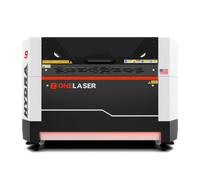Laser engraving leather is a highly specialized process—and choosing the best leather for laser engraving is the first and most important step to getting clean, consistent, and professional results. The wrong leather can lead to incomplete burns, toxic fumes, or material warping, while the right type enables precise detail, deep contrast, and safe operation.
For users of the OneLaser engraving machines, which are designed to handle both engraving and cutting with high repeatability, the leather you choose will directly impact the quality of your output. This article breaks down everything you need to know to select the best leather for laser cutting and engraving, from material type and thickness to machine settings and storage.

1. What Types of Leather for Laser Engraving/Cutting?
When working with laser systems—especially CO₂ lasers like those used in the OneLaser X Series and Hydra Series—not all leathers behave the same. The tanning process, surface treatment, and chemical composition of a hide will determine whether it engraves cleanly, emits hazardous fumes, or damages your machine.
Choosing the best leather for laser engraving starts with understanding what’s in the leather and how it will react under concentrated heat and light. Below, we break down the most common leather categories, their laser compatibility, and what to avoid.
1.1 Laser-Friendly Leathers
These materials are safe, consistent, and produce high-quality results under laser processing:
● Vegetable-Tanned Leather
This is the preferred choice for most professional leather laser engraving applications. It is tanned using organic materials—typically bark, leaves, and plant tannins—without synthetic chemicals. This gives the leather a neutral base that:
- Engraves with high contrast, darkening under the laser beam without flaring or melting.
- Produces minimal fumes, allowing for safer indoor use with proper exhaust.
- Holds its shape well, meaning cuts are crisp and dimensionally stable.
- Smells natural during processing—no harsh or synthetic chemical burn-off.
Ideal for:
- Custom logos
- Stamping emulation
- Deep vector cuts
- Branding elements on wallets, belts, and labels
Vegetable-tanned leather also ages well and can be tooled post-engraving, making it a premium material for both hobbyists and commercial shops.
● Tumbled, Full-Grain, or Tooling-Grade Veg-Tan
These are variants of standard veg-tan leather and maintain the same laser compatibility. Depending on processing:
- Tumbled leather will feel softer, making it better for pliable applications like wrap journals or straps.
- Full-grain leather retains more of the hide’s natural structure and texture, giving it a richer visual character after engraving.
These leathers engrave just as cleanly as untreated veg-tan but may produce slight tonal variations due to texture or finish.
1.2 Leathers to Avoid
Some leathers may seem appealing due to texture or price but are not safe or effective to use with a leather laser engraver.
● Chrome-Tanned Leather
By far the most common type in the fashion and furniture industries, chrome-tanned leather is tanned using chromium salts and other synthetic agents. While it's durable and color-fast, it poses serious issues during laser processing:
- Releases toxic fumes (including chromium compounds) when burned.
- Can damage laser optics due to chemical vapor deposits.
- Produces inconsistent engraving results, often resulting in a dull gray mark with low contrast.
Lasering chrome-tanned leather can also void warranties on machines due to corrosion risks and health hazards. It is strongly discouraged for any laser engraving or cutting.
● Synthetic Leather (PU, Faux Leather, Vinyl)
Often marketed as “eco-leather” or “vegan leather,” synthetic options are usually made from polyurethane (PU) or polyvinyl chloride (PVC). These are plastics, not true leathers, and require strict handling protocols.
- PVC-based synthetics emit hydrochloric acid gas when lasered—extremely toxic and corrosive.
- PU-based materials can be laser-compatible only if they’re PVC-free, but still produce more fumes and require higher ventilation standards.
- Surface coatings on synthetics can melt, bubble, or char instead of engraving cleanly.
If you must use synthetic leather, always:
- Verify it’s PVC-free.
- Request a Material Safety Data Sheet (MSDS) from your supplier.
- Conduct a ventilation audit to ensure safe operation.
2. Key Factors to Consider When Choosing Leather for Laser Engraving
To get the best results with a leather laser engraver, evaluate each material based on a few critical properties. Each factor affects how the leather reacts under laser exposure, including cut quality, engraving depth, contrast, and consistency. These considerations are especially relevant when using high-precision laser engraver.
2.1 Thickness
- 1–2 oz (0.4–0.8 mm): Lightweight leathers are ideal for laser cutting with fine detail. You can produce delicate shapes, cut-through labels, and flexible components without requiring excessive power or multiple passes. These are often used in fashion accessories, inserts, and patches. Because of their thin profile, the risk of char or edge distortion is reduced, especially when paired with an air assist system.
- 3–4 oz (1.2–1.6 mm): This range provides enough density for deep raster engraving without risking through-cuts or structural failure. It's perfect for projects like logo branding, emboss-style textures, or decorative panels. Leathers in this range also maintain surface tension well, which helps preserve engraving sharpness. However, users should reduce speed slightly to ensure full burn-in of darker lines.
- 5+ oz (2.0 mm+): Thicker hides require higher power and slower passes to engrave or cut effectively. These leathers can be used for high-impact applications like armor pieces, belts, or tool pouches, but may not be ideal for detailed work unless you’re focused on surface-level etching only. Cutting through heavy leather often demands multiple vector passes and proper material anchoring to avoid flameups or misalignment.
Tip: For any thickness, always run a test cut or engraving swatch to validate your settings before final production.
2.2 Surface Finish
The texture and treatment of the leather surface influence how the laser beam interacts with the material, particularly with engraving resolution and edge cleanliness.
- Smooth, untreated surfaces result in cleaner engravings with high contrast. These surfaces allow the laser beam to engrave consistently across the entire design without deflection or interference. Ideal for detailed raster images, text, and sharp logos.
- Coated, waxed, or oiled surfaces can cause uneven burns, as the coating may vaporize or melt before the laser reaches the leather beneath. This often leads to blotching, uneven contrast, and soot accumulation around the edges. Some oils or waxes may also ignite at low temperatures, which introduces a fire risk if airflow is poor.
- Avoid overly glossy leather, such as patent finishes or high-polish synthetics. These reflect laser energy, making the engraving unpredictable and reducing beam efficiency. In extreme cases, reflections may scatter and reduce the accuracy of the laser path.
2.3 Color
Color affects how well the engraving is visible after the laser burns the surface. Some leathers engrave well but offer low contrast, which reduces readability or visual impact—especially for branding or personalization work.
- Light tan or beige leathers produce the highest contrast after engraving. The heat from the laser darkens the fibers beneath the surface, creating a deep brown or black burn mark. These shades are excellent for logos, QR codes, or any graphics requiring legibility.
- Darker shades may still work but often require more passes or higher power settings to make the engraving visible. Burn marks may blend into the surface color, especially with deep browns, burgundies, or blacks. For these, either reduce speed or engrave at higher DPI with slower scan intervals to increase shading visibility.
3. Recommended Leather Types for Laser Engraving and Laser Cutting
Here are the most reliable and widely used leather types for laser work, all of which are compatible with the best leather laser engraver systems like the OneLaser X Series and Hydra Series.
3.1 Cowhide
- Durable, accessible, and consistent in grain.
- Great for making engraved wallets, notebook covers, and product tags.
- Cuts well in 1.5–3 mm thickness range.
3.2 Lambskin
- Extremely soft with a tight, fine grain.
- Excellent for delicate detail work and shallow rastering.
- Best for fashion items and personalized engraving.
3.3 Pigskin
- Strong, breathable, and uniquely textured.
- Holds shape after laser cutting and responds well to vector scoring.
3.4 Goatskin
- Flexible and highly resistant to stretching.
- Great for projects requiring shape retention or fine engraving resolution.
These options are the most consistent choices for achieving professional results with a laser engraving machine for leather products.
4. Machine Optimization: OneLaser X Series and Hydra Series for Leather
Your machine setup must match the leather’s properties. Both OneLaser X Series and Hydra Series are fully equipped for precision leather work—but must be dialed in properly.
4.1 Engraving Setup Tips:
- Power: Start at 15–25% for raster; increase for deeper burns.
- Speed: 300–500 mm/s keeps burn light and prevents scorching.
- Line Interval: Set to 0.1 mm for detailed engraving.
4.2 Cutting Setup Tips:
- Power: 70–90% depending on thickness.
- Speed: 5–15 mm/s for clean edge separation.
- Passes: For thick hides, run multiple shallow passes instead of one deep one.
4.3 Focus & Bed Settings:
- Use autofocus on Hydra Series or manual adjustment on X Series to focus on surface height.
- Apply honeycomb or blade bed to reduce back-burn and allow for airflow.
Laser engraving leather becomes dramatically more predictable with the correct setup.
5. Application Examples: Real Use Cases for Leather Laser Work
Knowing how and where to apply your leather laser skills unlocks new revenue streams. The best leather for laser engraving is used across multiple industries.
Popular Applications:
- Custom leather goods: Wallets, belts, pouches, bookmarks.
- Corporate gifting: Engraved coasters, name tags, keychains.
- Fashion & retail branding: Leather labels, patches, product inserts.
- Crafts & DIY: Personal hobby projects and Etsy storefronts.
Each of these use cases takes full advantage of a laser engraving machine for leather, especially when run on OneLaser equipment.
6. Safety Considerations in Leather Laser Processing
Working with leather safely is just as important as choosing the right leather itself. Key Safety Tips:
- Ventilation: Leather produces particulates and smoke. Use active exhaust or filtration.
- Avoid toxic materials: Do not engrave PVC-based synthetics or chrome-tanned leather.
- PPE: Use laser-rated glasses and gloves when working with active laser machines and handling recently cut materials.
Following these practices ensures safe operation and protects your laser cutting machine for leather long term.
7. How to Store Leather for Laser Engraving and Cutting
Even the best leather for laser engraving can become unusable if stored improperly. Keep it in controlled conditions to ensure uniform engraving and cut behavior. Leather Storage Tips:
- Flat storage: Prevents wrinkles or warping, which affect laser focus and depth.
- Climate control: Store in environments between 40–60% humidity and 18–24°C (65–75°F).
- Avoid sunlight: Prolonged exposure fades color and damages surface consistency.
When your leather is flat, dry, and stable, it engraves more predictably—reducing job errors and waste.
Conclusion
To get professional, consistent results from your laser engraving machine for leather, you must start with the right material. The best leather for laser engraving is clean, natural, and matched to your application. Combine this with proper machine setup, safe operating procedures, and reliable storage, and your output will consistently meet production-level standards.
Whether you're using the OneLaser X Series for fine raster detail or the Hydra Series for high-volume leather cutting jobs, material selection remains the foundation of success.

 Liquid error (sections/image-banner line 171): invalid url input
Liquid error (sections/image-banner line 171): invalid url input




